Samsung CLP-775ND Service Manual

Color Laser Printer
CLP-775ND series
SERVICEMANUAL
Color Laser Printer |
|
Contents |
1. Precautions
2. Product spec and feature
3. Disassembly and Reassembly
4. Alignment and Troubleshooting
5. System Diagram
6. Reference Information
Refer to the service manual in the GSPN (see the rear cover) for more information.

Contents
Contents
1. Precautions ...................................................................................................................................... |
|
|
1 |
− |
1 |
|
1.1. |
Safety warning ........................................................................................................................ |
|
1 |
− |
1 |
|
1.2. |
Caution for safety .................................................................................................................... |
|
1 |
− |
2 |
|
|
1.2.1. |
Toxic material............................................................................................................. |
1 |
− |
2 |
|
|
1.2.2. Electric shock and fire safety precautions ......................................................................... |
1 |
− |
2 |
||
|
1.2.3. |
Handling precautions ................................................................................................... |
1 |
− |
3 |
|
|
1.2.4. Assembly and Disassembly precautions........................................................................... |
1 |
− |
3 |
||
|
1.2.5. Disregarding this warning may cause bodily injury ............................................................ |
1 |
− |
4 |
||
1.3. |
ESD precautions...................................................................................................................... |
|
1 |
− |
5 |
|
2. Product spec and feature..................................................................................................................... |
|
2 |
− |
1 |
||
2.1. |
Product Specifications .............................................................................................................. |
2 |
− |
1 |
||
|
2.1.1. |
Product Overview........................................................................................................ |
2 |
− |
1 |
|
|
2.1.2. |
Specifications ............................................................................................................. |
2 |
− |
2 |
|
|
|
2.1.2.1. |
General Print Engine...................................................................................... |
2 |
− |
2 |
|
|
2.1.2.2. |
Controller and Software.................................................................................. |
2 |
− |
2 |
|
|
2.1.2.3. |
Paper Handling............................................................................................. |
2 |
− |
3 |
|
|
2.1.2.4. |
Reliability & Service ..................................................................................... |
2 |
− |
4 |
|
|
2.1.2.5. |
Consumables................................................................................................ |
2 |
− |
4 |
|
|
2.1.2.6. |
Maintenance part........................................................................................... |
2 |
− |
5 |
|
|
2.1.2.7. |
Environment ................................................................................................ |
2 |
− |
6 |
|
|
2.1.2.8. |
Packing & Accessory..................................................................................... |
2 |
− |
6 |
|
|
2.1.2.9. |
Options ....................................................................................................... |
2 |
− |
6 |
|
2.1.3. |
Model Comparison Table.............................................................................................. |
2 |
− |
7 |
|
2.2. |
System Overview..................................................................................................................... |
|
2 |
− |
8 |
|
|
2.2.1. |
Front View................................................................................................................. |
2 |
− |
8 |
|
|
2.2.2. |
Rear View |
.................................................................................................................. |
2 |
− |
9 |
|
2.2.3. |
Paper Path.................................................................................................................. |
2 |
− 10 |
||
|
2.2.4. |
System Layout............................................................................................................ |
2 |
− 11 |
||
|
|
2.2.4.1. |
Feeding Section ............................................................................................ |
2 |
− 12 |
|
|
|
2.2.4.2. |
Fuser Unit.................................................................................................... |
2 |
− 13 |
|
|
|
2.2.4.3. |
Drive Unit ................................................................................................... |
2 |
− 14 |
|
|
|
2.2.4.4. LSU (Laser Scanner Unit)............................................................................... |
2 |
− 15 |
||
|
|
2.2.4.5. PTB (Paper Transfer Belt) Unit........................................................................ |
2 |
− 16 |
||
|
|
2.2.4.6. |
Toner Cartridge............................................................................................. |
2 |
− 17 |
|
|
2.2.5. |
Hardware Configuration................................................................................................ |
2 |
− 18 |
||
|
|
2.2.5.1. |
Main PBA ................................................................................................... |
2 |
− 19 |
|
|
|
2.2.5.2. |
SMPS board................................................................................................. |
2 |
− 21 |
|
|
|
2.2.5.3. |
HVPS Board ................................................................................................ |
2 |
− 23 |
|
i |
Copyright© 1995-2016 SAMSUNG. All rights reserved. |

Contents
|
|
|
2.2.5.4. |
HVPS sub board ........................................................................................... |
2 |
− 25 |
|
|
|
|
2.2.5.5. |
Fuser Drive Board......................................................................................... |
2 |
− 26 |
|
|
|
|
2.2.5.6. |
OPE Board................................................................................................... |
2 |
− 27 |
|
|
|
|
2.2.5.7. |
Sensor......................................................................................................... |
2 |
− 28 |
|
|
|
2.2.6. |
Software Descriptions .................................................................................................. |
2 |
− 30 |
||
|
|
|
2.2.6.1. |
Overview..................................................................................................... |
2 |
− 30 |
|
|
|
|
2.2.6.2. |
Architecture ................................................................................................. |
2 |
− 30 |
|
|
|
|
2.2.6.3. Data and Control Flow ................................................................................... |
2 |
− 31 |
||
3. |
Disassembly and Reassembly .............................................................................................................. |
3 |
− |
1 |
|||
|
3.1. Precautions when replacing parts ................................................................................................ |
3 |
− |
1 |
|||
|
|
3.1.1. |
Precautions when assembling and disassembling ............................................................... |
3 |
− |
1 |
|
|
|
3.1.2. |
Preautions when handling PBA ...................................................................................... |
3 |
− |
1 |
|
|
|
3.1.3. |
Releasing Plastic Latches.............................................................................................. |
3 |
− |
2 |
|
|
3.2. Screws used in the printer.......................................................................................................... |
3 |
− |
3 |
|||
|
3.3. Replacing a maintenance parts.................................................................................................... |
3 |
− |
6 |
|||
|
|
3.3.1. |
Fuser Unit |
.................................................................................................................. |
3 |
− |
6 |
|
|
3.3.2. |
Pick-Up roller............................................................................................................. |
3 |
− |
7 |
|
|
|
3.3.3. |
Retard Roller.............................................................................................................. |
3 |
− |
8 |
|
|
|
3.3.4. |
Dust Cleaning Kit........................................................................................................ |
3 |
− |
9 |
|
|
3.4. |
Disassembly Procedure............................................................................................................. |
3 |
− 10 |
|||
|
|
3.4.1. |
Cover........................................................................................................................ |
|
3 |
− 10 |
|
|
|
3.4.2. |
Front Cover................................................................................................................ |
3 |
− 13 |
||
|
|
3.4.3. |
OPE Unit................................................................................................................... |
|
3 |
− 14 |
|
|
|
3.4.4. |
Main PBA.................................................................................................................. |
3 |
− 14 |
||
|
|
3.4.5. |
HVPS board ............................................................................................................... |
3 |
− 15 |
||
|
|
3.4.6. |
SMPS Board............................................................................................................... |
3 |
− 15 |
||
|
|
3.4.7. |
HVPS Sub Board (AC Board)........................................................................................ |
3 |
− 16 |
||
|
|
3.4.8. |
Fuser Control Board..................................................................................................... |
3 |
− 17 |
||
|
|
3.4.9. |
LSU.......................................................................................................................... |
|
3 |
− 18 |
|
|
|
3.4.10. |
Clutch Pick-Up and Clutch-Feed .................................................................................... |
3 |
− 19 |
||
4. |
Alignment and Troubleshooting ........................................................................................................... |
4 |
− |
1 |
|||
|
4.1. |
Alignment and Adjustments....................................................................................................... |
4 |
− |
1 |
||
|
|
4.1.1. |
Control Panel.............................................................................................................. |
4 |
− |
1 |
|
|
|
4.1.2. |
Understanding The Status LED ...................................................................................... |
4 |
− |
2 |
|
|
|
4.1.3. |
JAM Removal............................................................................................................. |
4 |
− |
3 |
|
|
|
|
4.1.3.1. |
Clearing Paper Jams ...................................................................................... |
4 |
− |
3 |
|
|
4.1.4. |
Useful menu item for service ......................................................................................... |
4 |
− |
7 |
|
|
|
4.1.5. |
Periodic Defective Image.............................................................................................. |
4 |
− |
8 |
|
|
|
4.1.6. |
Useful management tools.............................................................................................. |
4 |
− |
9 |
|
|
|
|
4.1.6.1. Using Samsung Easy Printer Manager (Windows only) ........................................ |
4 |
− |
9 |
|
Copyright© 1995-2016 SAMSUNG. All rights reserved. |
ii |

Contents
|
|
|
4.1.6.2. Using Samsung Printer Status (Windows only) ................................................... |
4 |
− 10 |
|
|
|
|
4.1.6.3. Using Smart Panel (Macintosh and Linux only) .................................................. |
4 |
− 12 |
|
|
|
4.1.7. |
Updating Firmware...................................................................................................... |
4 |
− 14 |
|
|
|
|
4.1.7.1. Update the firmware by using the USB port........................................................ |
4 |
− 14 |
|
|
|
|
4.1.7.2. Update the firmware by using the network.......................................................... |
4 |
− 15 |
|
|
|
4.1.8. |
Tech Mode................................................................................................................. |
4 |
− 17 |
|
|
|
|
4.1.8.1. To enter the Tech Mode .................................................................................. |
4 |
− 17 |
|
|
|
|
4.1.8.2. Tech Mode Menu Map ................................................................................... |
4 |
− 18 |
|
|
|
|
4.1.8.3. Tech Mode Menu description........................................................................... |
4 |
− 19 |
|
|
4.2. |
Troubleshooting ...................................................................................................................... |
4 |
− 24 |
||
|
|
4.2.1. Procedure of Checking the Symptoms ............................................................................. |
4 |
− 24 |
||
|
|
|
4.2.1.1. Basic Check List ........................................................................................... |
4 |
− 25 |
|
|
|
4.2.2. Error code and troubleshooting ...................................................................................... |
4 |
− 26 |
||
|
|
4.2.3. |
Image quality problems ................................................................................................ |
4 |
− 60 |
|
|
|
4.2.4. |
Other errors................................................................................................................ |
4 |
− 64 |
|
5. |
System Diagram................................................................................................................................ |
5 |
− |
1 |
||
|
5.1. |
Block Diagram........................................................................................................................ |
5 |
− |
1 |
|
|
5.2. |
Connection Diagram................................................................................................................. |
5 |
− |
2 |
|
6. |
Reference Information........................................................................................................................ |
6 |
− |
1 |
||
|
6.1. |
Tool for Troubleshooting........................................................................................................... |
6 |
− |
1 |
|
|
6.2. |
Acronyms and Abbreviations ..................................................................................................... |
6 |
− |
2 |
|
|
|
6.2.1. |
Acronyms .................................................................................................................. |
6 |
− |
2 |
|
|
6.2.2. |
Service Parts............................................................................................................... |
6 |
− |
4 |
|
6.3. The Sample Pattern for the Test .................................................................................................. |
6 |
− |
7 |
||
|
|
6.3.1. A4 ISO 19798 Standard Pattern...................................................................................... |
6 |
− |
7 |
|
|
6.4. |
Selecting a location .................................................................................................................. |
6 |
− |
8 |
|
iii |
Copyright© 1995-2016 SAMSUNG. All rights reserved. |

1. Precautions
1. Precautions
In order to prevent accidents and damages to the equipment please read the precautions listed below carefully before servicing the product and follow them closely.
1.1. Safety warning
1)Only to be serviced by a factory trained service technician.
High voltages and lasers inside this product are dangerous. This product should only be serviced by a factory trained service technician.
2)Use only Samsung replacement parts.
There are no user serviceable parts inside the product. Do not make any unauthorized changes or additions to the product as these could cause the product to malfunctions and create an electric shocks or fire hazards.
3)Laser Safety Statement
The printer is certified in the U.S. to conform to the requirements of DHHS 21 CFR, chapter 1 Subchapter J for Class I(1) laser products, and elsewhere is certified as a Class I laser product conforming to the requirements of IEC/EN 60825-1:2014. Class I laser products are not considered to be hazardous. The laser system and printer are designed so there is never any human access to laser radiation above a Class I level during normal operation, user maintenance or prescribed service condition.
•Wavelength: 800 nm
•Beam divergence
-Parallel: 11 degrees
-Perpendicular: 35 degrees
•Maximum power of energy output: 12 mW
 WARNING
WARNING
Never operate or service the product with the protective cover removed from Laser/Scanner assembly. The reflected beam, although invisible, can damage your eyes.
When using this product, these basic safety precautions should always be followed to reduce risk of fire, electric shock, and personal injury.
4) Lithium battery not replaceable by user
Copyright© 1995-2016 SAMSUNG. All rights reserved. |
1-1 |

1. Precautions
1.2. Caution for safety
1.2.1. Toxic material
This product contains toxic materials that could cause illness if ingested.
1)Please keep imaging unit and toner cartridge away from children. The toner powder contained in the imaging unit and toner cartridge may be harmful, and if swallowed, you should contact a doctor.
1.2.2. Electric shock and fire safety precautions
Failure to follow the following instructions could cause electric shock or potentially cause a fire.
1)Use only the correct voltage, failure to do so could damage the product and potentially cause a fire or electric shock.
2)Use only the power cable supplied with the product. Use of an incorrectly specified cable could cause the cable to overheat and potentially cause a fire.
3)Do not overload the power socket, this could lead to overheating of the cables inside the wall and could lead to a fire.
4)Do not allow water or other liquids to spill into the product, this can cause electric shock. Do not allow paper clips, pins or other foreign objects to fall into the product, these could cause a short circuit leading to an electric shock or fire hazard.
5)Never touch the plugs on either end of the power cable with wet hands, this can cause electric shock. When servicing the product, remove the power plug from the wall socket.
6)Use caution when inserting or removing the power connector. When removing the power connector, grip it firmly and pull. The power connector must be inserted completely, otherwise a poor contact could cause overheating possibly leading to a fire.
7)Take care of the power cable. Do not allow it to become twisted, bent sharply around corners or wise damaged. Do not place objects on top of the power cable. If the power cable is damaged it could overheat and cause a fire. Exposed cables could cause an electric shock. Replace the damaged power cable immediately, do not reuse or repair the damaged cable. Some chemicals can attack the coating on the power cable, weakening the cover or exposing cables causing fire and shock risks.
8)Ensure that the power sockets and plugs are not cracked or broken in any way. Any such defects should be repaired immediately. Take care not to cut or damage the power cable or plugs when moving the machine.
9)Use caution during thunder or lightning storms. Samsung recommends that this machine be disconnected from the power source when such weather conditions are expected. Do not touch the machine or the power cord if it is still connected to the wall socket in these weather conditions.
10)Avoid damp or dusty areas, install the product in a clean well ventilated location. Do not position the machine near a humidifier or in front of an air conditioner. Moisture and dust built up inside the machine can lead to overheating and cause a fire or cause parts to rust.
11)Do not position the product in direct sunlight. This will cause the temperature inside the product to rise possibly leading to the product failing to work properly and in extreme conditions could lead to a fire.
12)Do not insert any metal objects into the machine through the ventilator fan or other part of the casing, it could make contact with a high voltage conductor inside the machine and cause an electric shock.
1-2 |
Copyright© 1995-2016 SAMSUNG. All rights reserved. |

1. Precautions
1.2.3. Handling precautions
The following instructions are for your own personal safety to avoid injury and so as not to damage the product.
1)Ensure the product is installed on a level surface, capable of supporting its weight. Failure to do so could cause the product to tip or fall.
2)The product contains many rollers, gears and fans. Take great care to ensure that you do not catch your fingers, hair or clothing in any of these rotating devices.
3)Do not place any small metal objects, containers of water, chemicals or other liquids close to the product which if spilled could get into the machine and cause damage or a shock or fire hazard.
4)Do not install the machine in areas with high dust or moisture levels, beside on open window or close to a humidifier or heater. Damage could be caused to the product in such areas.
5)Do not place candles, burning cigarettes, etc on the product, These could cause a fire.
6)Ensure that the machine is installed and used in proper area to meet the temperature and humidity specifications.
•If the machine is stored at below zero Celsius for a long time, do not use the machine instantly after movement. It can malfunction. Take care of the machine storage. If the machine is stored at below zero Celsius for a long time, keep the machine at room temperature and install it.
1.2.4. Assembly and Disassembly precautions
Replace parts carefully and always use Samsung parts. Take care to note the exact location of parts and also cable routing before dismantling any part of the machine. Ensure all parts and cables are replaced correctly. Please carry out the following procedures before dismantling the product or replacing any parts.
1)Check the contents of the machine memory and make a note of any user settings. These will be erased if the main board or network card is replaced.
2)Ensure that power is disconnected before servicing or replacing any electrical parts.
3)Disconnect interface cables and power cables.
4)Only use approved spare parts. Ensure that part number, product name, any voltage, current or temperature rating are correct.
5)When removing or re-fitting any parts do not use excessive force, especially when fitting screws into plastic.
6)Take care not to drop any small parts into the machine.
7)Handling of the OPC Drum
•The OPC Drum can be irreparably damaged if it exposed to light. Take care not to expose the OPC Drum either to direct sunlight or to fluorescent or incandescent room lighting. Exposure for as little as 5 minutes can damage the surface of the photoconductive properties and will result in print quality degradation. Take extra care when servicing the product. Remove the OPC Drum and store it in a black bag or other lightproof container. Take care when working with the Covers (especially the top cover) open as light is admitted to the OPC area and can damage the OPC Drum.
•Take care not to scratch the green surface of OPC Drum Unit. If the green surface of the Drum Cartridge is scratched or touched the print quality will be compromised.
Copyright© 1995-2016 SAMSUNG. All rights reserved. |
1-3 |

1. Precautions
1.2.5. Disregarding this warning may cause bodily injury
1)Be careful with the high temperature part.
The fuser unit works at a high temperature. Use caution when working on the printer. Wait for the fuser to cool down before disassembly.
2)Do not put finger or hair into the rotating parts.
When operating a printer, do not put hand or hair into the rotating parts (Paper feeding entrance, motor, fan, etc.). If do, you can get harm.
3)When you move the printer.
This printer weighs 6kg including toner cartridge and cassette. Use safe lifting and handling techniques. Use the lifting handles located on each side of the machine. Back injury could be caused if you do not lift carefully.
4)Ensure the printer is installed safely.
The printer weighs 6kg, ensure the printer is installed on a level surface, capable of supporting its weight. Failure to do so could cause the printer to tip or fall possibly causing personal injury or damaging the printer.
5)Do not install the printer on a sloping or unstable surface. After installation, double check that the printer is stable.
1-4 |
Copyright© 1995-2016 SAMSUNG. All rights reserved. |

1. Precautions
1.3. ESD precautions
Certain semiconductor devices can be easily damaged by static electricity. Such components are commonly called “Electrostatically Sensitive (ES) Devices” or ESDs. Examples of typical ESDs are: integrated circuits, some field effect transistors, and semiconductor “chip” components. The techniques outlined below should be followed to help reduce the incidence of component damage caused by static electricity.
 CAUTION
CAUTION
Be sure no power is applied to the chassis or circuit, and observe all other safety precautions.
1)Immediately before handling a semiconductor component or semiconductor-equipped assembly, drain off any electrostatic charge on your body by touching a known earth ground. Alternatively, employ a commercially available wrist strap device, which should be removed for your personal safety reasons prior to applying power to the unit under test.
2)After removing an electrical assembly equipped with ESDs, place the assembly on a conductive surface, such as aluminum or copper foil, or conductive foam, to prevent electrostatic charge buildup in the vicinity of the assembly.
3)Use only a grounded tip soldering iron to solder or desolder ESDs.
4)Use only an “anti-static” solder removal device. Some solder removal devices not classified as “anti-static” can generate electrical charges sufficient to damage ESDs.
5)Do not use Freon-propelled chemicals. When sprayed, these can generate electrical charges sufficient to damage ESDs.
6)Do not remove a replacement ESD from its protective packaging until immediately before installing it. Most replacement ESDs are packaged with all leads shorted together by conductive foam, aluminum foil, or a comparable conductive material.
7)Immediately before removing the protective shorting material from the leads of a replacement ESD, touch the protective material to the chassis or circuit assembly into which the device will be installed.
8)Maintain continuous electrical contact between the ESD and the assembly into which it will be installed, until completely plugged or soldered into the circuit.
9)Minimize bodily motions when handling unpackaged replacement ESDs. Normal motions, such as the brushing together of clothing fabric and lifting one’s foot from a carpeted floor, can generate static electricity sufficient to damage an ESD.
Copyright© 1995-2016 SAMSUNG. All rights reserved. |
1-5 |

2. Product spec and feature
2. Product spec and feature
2.1. Product Specifications
2.1.1. Product Overview
1)Speed
•33 (Color) / 33 (Black) ppm in A4 (35 / 35 ppm in Letter)
2)Processor
•600 MHz
3)Printer Language
•PS3, PCL5c, PCL6, PDF 1.4
4)Memory
•384 MB (Standard) / 896 MB (Max)
5)Interface
•High Speed USB 2.0
•10/100/1000 BaseTX network connector
•802.11b/g/n wireless LAN (Optional)
•IEEE 1284 Parallel (Optional)
•HDD 250 GB (Optional)
6)Toner cartridge
•Initial : 3.5K (K)/ 3.5K (CMY)
•Sales: 7K (K)/ 7K (CMY)
7)Paper Handling
•Maximum 1,600 Sheets Paper Capacity (500sh cassette, 500sh SCF x 2 EA, 100 MP)
2-1 |
Copyright© 1995-2016 SAMSUNG. All rights reserved. |

2. Product spec and feature
2.1.2. Specifications
•Product Specifications are subject to change without notice. See below for product specifications.
2.1.2.1. General Print Engine
|
Items |
|
Specification |
|
|
|
Simplex |
• B&W : Up to 33 ppm in A4 (35 ppm in Letter) |
|
|
|
• Color : Up to 33 ppm in A4 (35 ppm in Letter) |
||
Engine Speed |
|
|
||
|
|
|
|
|
|
Duplex |
• B&W : Up to 14 ppm in A4 (14 ppm in Letter) |
||
|
|
|||
|
|
• Color : Up to 14 ppm in A4 (14 ppm in Letter) |
||
|
|
|
||
|
|
|
|
|
Warm-up time |
|
From Sleep |
≤ 25 sec |
|
|
|
|
|
|
FPOT (B&W) |
|
From Ready |
≤ 10 sec |
|
|
|
|
|
|
|
From Sleep |
≤ 28 sec |
||
|
|
|||
|
|
|
|
|
FPOT (Color) |
|
From Ready |
≤ 11 sec |
|
|
|
|
|
|
|
From Sleep |
≤ 30 sec |
||
|
|
|||
|
|
|
|
|
|
|
Optical |
600 x 600 dpi |
|
|
|
|
|
|
|
|
|
• |
PCL |
|
|
|
|
• Best : 9,600 x 600 effective output |
Resolution |
|
|
|
• Normal : 2,400 x 600 dpi |
|
Support |
|
• Draft : 600 x 600 dpi |
|
|
|
|
||
|
|
• |
PostScript 3 |
|
|
|
|
||
|
|
|
|
• Best : 9,600 x 600 effective output |
|
|
|
|
• Normal : 1,200 x 600 dpi |
|
|
|
|
• Draft : 600x600 dpi |
|
|
|
|
|
2.1.2.2. Controller and Software
Items |
|
Specification |
||
Processor |
600 |
MHz |
||
|
|
|
|
|
Memory |
Std. |
384 |
MB |
|
|
|
|
||
Max |
896 MB |
|||
|
||||
|
|
|
||
Printer Languages |
PS3, PCL5 ,PLC6 |
|||
|
|
|||
Fonts |
93 scalable ,1 bitmap PCL ,136 PS |
|||
|
|
|
|
|
Copyright© 1995-2016 SAMSUNG. All rights reserved. |
2-2 |

2. Product spec and feature
|
Items |
|
|
Specification |
|
Driver |
|
Default Driver |
PCL6 |
|
|
|
|
|
|
||
|
|
Supporting OS |
Windows 2000/XP(32/64bits)/Vista(32/64bits)/2003 |
||
|
|
|
Server(32/64bits)/2008 Server(32/64bits) / Win7 /2008 R2 |
||
|
|
|
|
|
|
|
|
|
• |
Various Linux OS |
|
|
|
|
|
• |
Red Hat 8~9, |
|
|
|
|
• |
Fedora Core 1~4 |
|
|
|
|
• |
Mandrake 9.2~10.1 |
|
|
|
|
• |
SuSE 8.2~9.2 |
|
|
|
• |
Mac OS 10.3~10.6 |
|
|
|
|
|
||
|
|
WHQL |
Windows 2000/XP(32/64bits)/Vista(32/64bits)/2003 |
||
|
|
|
Server(32/64bits)/2008 Server(32/64bits) / Win7 /2008 R2 |
||
|
|
|
|
||
Application |
|
Management Tool |
Easy Print Management |
||
|
|
|
|
|
|
|
Network Management |
Set IP, SyncThru Web Admin Service 4.0 |
|||
|
|
||||
|
|
|
|
|
|
|
|
IEEE 1284 Parallel |
Optional |
|
|
|
|
|
|
||
Interface |
|
USB |
Hi-Speed USB 2.0 |
||
|
|
|
|
|
|
|
Wired Network |
Ethernet 10/100/1000 Base TX |
|||
|
|
||||
|
|
|
|
|
|
|
|
Wireless Network |
Optional |
|
|
|
|
|
|
||
User Interface |
|
LCD |
4–Line LCD |
||
|
|
|
|
|
|
|
LED |
1 Status LED |
|||
|
|
||||
|
|
|
|
|
|
2.1.2.3. Paper Handling
|
Items |
Specification |
|
Standard Capacity |
500-sheet Tray @ 80g/m² , 100–sheet MP Tray |
||
|
|
|
|
Max. Capacity |
|
|
1600 sheets @ 80g/m² (500–sheet basic Tray, 500–sheet SCF Tray x 2, 100–sheet |
|
|
MP) |
|
|
|
|
|
|
|
|
|
Printing |
|
Max. Size |
216 x 356 mm (8.5" x 14") |
|
|
|
|
|
Min. Size |
76 x 127 mm (3.0" x 5") |
|
|
|
||
|
|
|
|
|
|
Capacity |
500 sheets @ 80g/m² |
|
|
|
|
|
|
Media sizes |
76 x 127 mm (3” x 5”) ~ 216 x 356mm (8.5” x 14”) |
Standard Cassette |
|
|
|
|
Media types |
Plain paper |
|
Tray |
|
|
|
|
Media weight |
16~43lb (60 ~163 g/m²) |
|
|
|
||
|
|
|
|
|
|
Sensing |
Paper Empty |
|
|
|
|
|
|
Capacity |
100-sheet @ 80g/m² |
|
|
|
|
|
|
Media sizes |
A4 148.5 x 210 ~ Legal 216 x 356 (8.5”x14”) |
|
|
|
|
MP Tray |
|
Media types |
Printer Default, Plain Paper, Thick, Thin, Cotton, Archive Paper, Bond, Card |
|
Stock, Labels, Preprinted, Color Paper, Envelope, Recycled |
||
|
|
||
|
|
|
|
|
|
Media weight |
16~58lb (60 to 220g/m²) |
|
|
|
|
|
|
Sensing |
Paper Empty |
|
|
|
|
2-3 |
Copyright© 1995-2016 SAMSUNG. All rights reserved. |

|
|
|
2. Product spec and feature |
|
|
|
|
|
Items |
Specification |
|
|
|
Capacity |
500 sheets @ 80g/m² |
|
|
|
|
Optional Cassette |
|
Media sizes |
A5 148.5 x210mm ~ Legal 216 x 356mm (8.5" x 14") |
|
|
|
|
|
Media types |
Plain paper |
|
Tray |
|
||
|
|
|
|
|
Media weight |
16~43lb (60 ~ 163 g/m²) |
|
|
|
||
|
|
|
|
|
|
Sensing |
Paper Empty |
|
|
|
|
Output Stacking |
|
Face-Down |
250 sheets @ 80g/m² (Base Line Paper : Samsung Premium/ Xerox4200) NN |
|
Condition |
||
|
|
|
|
|
|
|
|
|
|
Supporting |
Standard |
|
|
|
|
Duplex |
|
Media sizes |
A4, Letter, Legal, Oficio, Folio |
|
|
|
|
|
Media types |
Palin paper only |
|
|
|
||
|
|
|
|
|
|
Media weight |
16~32lb (60 ~120g/m²) |
|
|
|
|
2.1.2.4. Reliability & Service
Items |
Specification |
Printing Volume (SET AMPV) |
1800 Pages , 1080/720 pages (Color and mono prints) |
|
|
Max Monthly Duty |
120,000 pages |
|
|
MPBF |
65,000 pages |
|
|
MTTR |
< 30 min. |
|
|
2.1.2.5. Consumables
Items |
Specification |
||
|
|
CLT-C609S (Cyan) |
|
|
Model |
CLT-M609S (Magenta) |
|
|
CLT-Y609S (Yellow) |
||
|
|
||
Toner Cartridge |
|
CLT-K609S (Black) |
|
|
|
• Initial (CMYK): Average Cartridge Yield 3.5K standard pages. |
|
|
Yield |
• Sales (CMYK): Average cartridge Yield 7K standard pages |
|
|
|
Declared cartridge yield in accordance with ISO/IEC 19798. |
|
|
|
|
|
Paper Transfer Belt (PTB) |
Model |
CLT-T508 |
|
|
|
||
Yield |
50K pages |
||
|
|||
|
|
|
|
Copyright© 1995-2016 SAMSUNG. All rights reserved. |
2-4 |

2. Product spec and feature
2.1.2.6. Maintenance part
|
Items |
Part Code |
Life |
UI Warning Message |
|
|
(Part Name) |
F: First, A: After "OK" Button |
|||
|
|
|
|||
|
|
|
|
[Low Status] |
|
|
|
JC96-05454B |
|
F: Prepare Fuser unit |
|
|
Fuser Unit |
(Fuser,110V) |
100K |
A: Prepare new fuser unit |
|
|
JC96-05455B |
Pages |
[Empty Status] |
||
|
|
||||
|
|
(Fuser,220V) |
|
F: Replace Fuser unit |
|
|
|
|
|
A: Replace with new fuser unit |
|
|
|
|
|
|
|
|
Pickup-Roller (Tray1) |
JC73-00340A |
100K |
N/A |
|
|
(RUBBER-PICK UP) |
Pages |
|||
|
|
|
|||
|
|
|
|
|
|
Main |
Retard Roller (Tray1) |
JC90-01063A |
100K |
F: Replace Retard roller |
|
Set |
(CASSETTE-RETARD) |
Pages |
A: Replace with new Tray1 Retard roller |
||
|
|||||
|
|
|
|
|
|
|
|
JC66-03043A |
100K |
|
|
|
Pickup-Roller (MPT) |
(ROLLER-RUBBER |
N/A |
||
|
Pages |
||||
|
|
P/UP MP) |
|
||
|
|
|
|
||
|
|
|
|
|
|
|
|
JC73-00132A |
100K |
|
|
|
Friction Pad (MPT) |
(RPR-FRICTION PAD |
N/A |
||
|
Pages |
||||
|
|
MP) |
|
||
|
|
|
|
||
|
|
JC93-00399A |
100K |
F: Replace Dust Cleaning |
|
|
Dust cleaning Kit |
(FRAME-REGI- |
|||
|
Pages |
A: Replace with new Dust Cleaning kit |
|||
|
|
CLEANING) |
|||
|
|
|
|
||
|
|
|
|
|
|
|
Pickup-Roller (Tray2) |
JC97-02259A |
200K |
N/A |
|
|
|
(MEA UNIT-ROLLER |
|
||
|
|
|
|||
|
Forward Roller (Tray2) |
Pages |
N/A |
||
|
PU) |
||||
SCF1 |
|
|
|
||
|
|
|
|
||
|
JC97-02259A |
100K |
F: Replace Retard roller |
||
|
|
||||
|
Retard Roller (Tray2) |
(MEA UNIT-ROLLER |
|||
|
Pages |
A: Replace with new Tray2 Retard roller |
|||
|
|
PU) |
|||
|
|
|
|
||
|
|
|
|
|
|
|
Pickup-Roller (Tray3) |
JC97-02259A |
200K |
N/A |
|
|
|
(MEA UNIT-ROLLER |
|
||
|
|
|
|||
|
Forward Roller (Tray3) |
Pages |
N/A |
||
|
PU) |
||||
SCF2 |
|
|
|
||
|
|
|
|
||
|
JC97-02259A |
100K |
F: Replace Retard roller |
||
|
|
||||
|
Retard Roller (Tray3) |
(MEA UNIT-ROLLER |
|||
|
Pages |
A: Replace with new Tray3 Retard roller |
|||
|
|
PU) |
|||
|
|
|
|
||
|
|
|
|
|
2-5 |
Copyright© 1995-2016 SAMSUNG. All rights reserved. |

|
|
2. Product spec and feature |
|
2.1.2.7. Environment |
|
|
|
|
|
|
|
Items |
Specification |
||
Operating Environment |
Temperature |
15 ~ 32.5 |
|
Humidity |
10% ~ 80% |
||
|
|||
|
|
|
|
Acoustic Noise Level |
Printing |
Less than 54 dBA |
|
|
|
||
Standby |
Less than 35 dBA |
||
(Sound Power/ Pressure) |
|||
|
|
||
Sleep |
Back Ground Level |
||
|
|||
|
|
|
|
Input Voltage |
|
110-127 VAC, 50/60Hz or 220-240 VAC, 50/60Hz |
|
|
|
|
|
|
Ready |
Less than 60 Wh |
|
|
|
|
|
Power Consumption |
AVG. |
Less than 750 Wh |
|
|
|
||
Max/Peak |
Less than 1000 Wh |
||
|
|||
|
|
|
|
|
Sleep |
Less than 8 Wh |
|
|
|
|
|
Dimension (W x D x H) |
SET |
446 x 481 x 464 mm (17.6 x 18.9 x 18.3 inches) without optional tray |
|
|
|
|
|
Weight |
SET with consumables |
30.4 kg (67 lbs) |
|
|
|
|
|
2.1.2.8. Packing & Accessory
Item |
Accessory |
|
|
Driver Install CD-ROM
Power Cable
USB Cable (CIS/China/Korea/India)
In-Box Quick Install Guide
Warranty Registration Card
User’s Manual (HTML)
Initial Toner Cartridge (CMYK)
2.1.2.9. Options
Items |
Model Name |
Remark |
Memory |
ML-MEM170 |
512MB |
|
|
|
Second Cassette Feeder |
CLP-S775 |
500–sheet Cassette |
|
|
|
Wireless Network |
ML-NWA65L |
|
|
|
|
Hard Disk |
ML-HDK 425 |
250 GB |
|
|
|
IEEE 1284B Parallel |
ML-PAR100 |
|
|
|
|
Copyright© 1995-2016 SAMSUNG. All rights reserved. |
2-6 |

2. Product spec and feature
2.1.3. Model Comparison Table
|
Samsung CLP-775ND |
Samsung CLP-770ND |
HP P1505n |
|
Image |
|
|
|
|
|
|
|
|
|
Mono/Color Speed (A4) |
33 ppm / 33 ppm |
32 ppm /32 ppm |
30 ppm / 30 ppm |
|
|
|
|
|
|
Processor |
600 MHz Dual Core |
800 MHz |
516 MHz |
|
|
|
|
|
|
Memory (Std/ Max) |
384 MB /896 MB |
256 MB / 768 MB |
256~512 MB / 1024 MB |
|
|
|
|
|
|
Print Language |
PCL5/6, PS3, PDF 1.4 |
PCL5/6, PS3, PDF 1.4 |
PCL5/6, PS3, PDF 1.4 |
|
|
|
|
|
|
Paper Input |
500 Cassette, 100 MP |
500 Cassette, 100 MP |
250 Cassette, 100 MP |
|
500 x 2 SCF |
500 x 2 SCF |
500 SCF |
||
|
||||
|
|
|
|
|
Duplex |
Std |
Std |
Std |
|
|
|
|
|
|
|
High Speed USB 2.0 |
High Speed USB 2.0 |
High Speed USB 2.0 |
|
Interface |
Gigabit Ethernet |
Gigabit Ethernet |
Gigabit Ethernet |
|
|
USB Host |
USB Host |
USB Host |
|
|
|
|
|
|
Size (mm) |
446 x 481 x 464 mm |
446 x 481 x 464 mm |
513 x 490 x 358 mm |
|
|
|
|
|
|
Toner Cartridge |
7K / 7K |
7K / 7K |
10.5K / 7K |
|
(Mono/Color) |
||||
|
|
|
||
|
|
|
|
2-7 |
Copyright© 1995-2016 SAMSUNG. All rights reserved. |

2. Product spec and feature
2.2. System Overview
This chapter describes the functions and operating principals of the printer.
2.2.1. Front View
This illustration may differ from your machine depending on its model.
1 |
Output Tray |
8 |
Front Cover Handle |
|
|
|
|
2 |
Output Support |
9 |
Front Cover |
|
|
|
|
3 |
Paper Level Indicator |
10 |
Control Panel |
|
|
|
|
4 |
Optional Tray * |
11 |
Multi-Purpose Tray Paper Width Guide |
|
|
|
|
5 |
Tray 1 |
12 |
Toner Cartridge |
|
|
|
|
6 |
Multi-Purpose Tray |
13 |
Paper Transfer Belt (PTB) |
|
|
|
|
7 |
Multi-Purpose Tray Handle |
|
|
|
|
|
|
* : This is an option feature.
Copyright© 1995-2016 SAMSUNG. All rights reserved. |
2-8 |
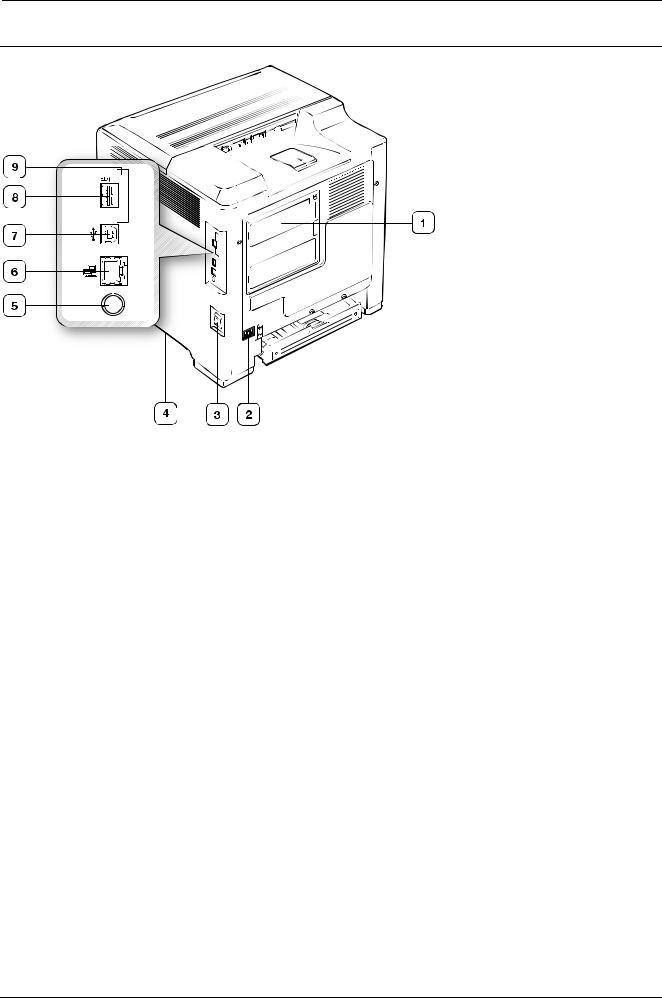
2. Product spec and feature
2.2.2. Rear View
This illustration may differ from your machine depending on its model.
1 |
Control Board cover |
6 |
Network Port |
|
|
|
|
2 |
Power receptacle |
7 |
USB Port |
|
|
|
|
3 |
Power-Switch |
8 |
External device interface (EDI)* |
|
|
|
|
4 |
Handle |
9 |
IEEE 802.11 b/g/n Wireless LAN** |
|
|
|
|
5 |
IEEE1284 Parallel Connector |
|
|
|
|
|
|
*: External device interface for Samsung and third party solutions.
**: This is an optional feature.
2-9 |
Copyright© 1995-2016 SAMSUNG. All rights reserved. |
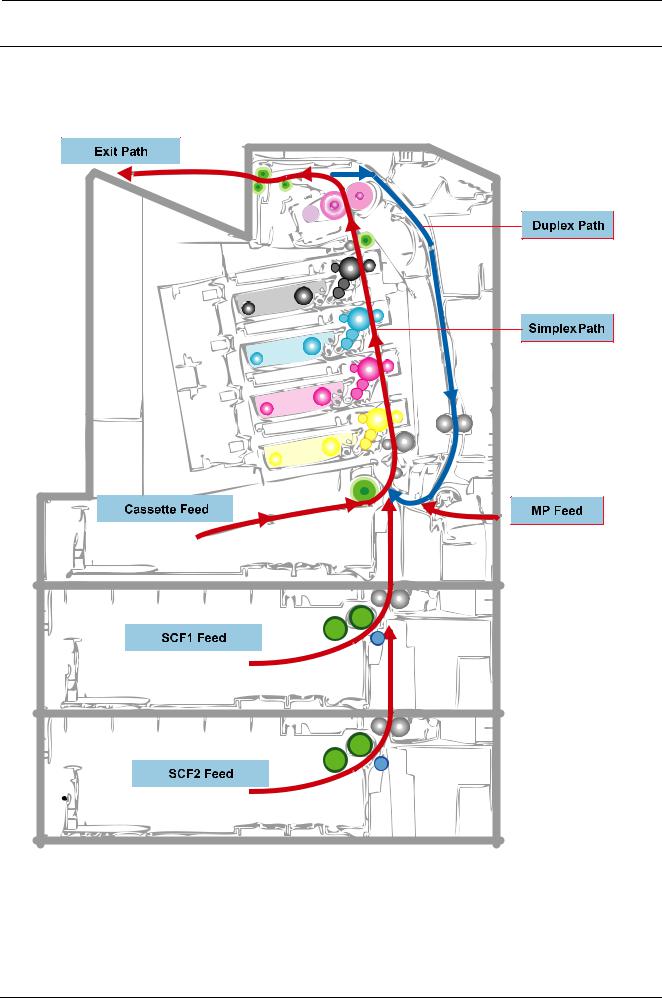
2. Product spec and feature
2.2.3. Paper Path
The following diagram displays the path the paper follows during the printing process.
Copyright© 1995-2016 SAMSUNG. All rights reserved. |
2-10 |

2. Product spec and feature
2.2.4. System Layout
This model consists of the mechanical parts and hardware parts. Mechanical parts consists of Frame, Feeding, Developing, Driving, Transferring, Fusing. Hardware parts consists of the main control board, SMPS board, HVPS board, Fuser control board, operation panel, PC Interface.
No |
Name |
No |
Name |
1 |
LSU |
10 |
OPE Unit |
|
|
|
|
2 |
Toner Cartridge (K) |
11 |
Fuser Unit |
|
|
|
|
3 |
Toner Cartridge (C) |
12 |
Paper Transfer Unit (PTB) |
|
|
|
|
4 |
Toner Cartridge (M) |
13 |
Main board / SMPS board / Fuser Drive |
|
|
|
Board (FDB) |
|
|
|
|
5 |
Toner Cartridge (Y) |
14 |
Pick-Up Roller |
|
|
|
|
6 |
Tray1 (Basic Tray) |
15 |
Retard Roller |
|
|
|
|
7 |
SCF Unit (Optional) |
16 |
Retard Roller |
|
|
|
|
8 |
Pick-Up Roller |
17 |
Pick-Up Roller |
|
|
|
|
9 |
Exit Roller |
|
|
|
|
|
|
2-11 |
Copyright© 1995-2016 SAMSUNG. All rights reserved. |
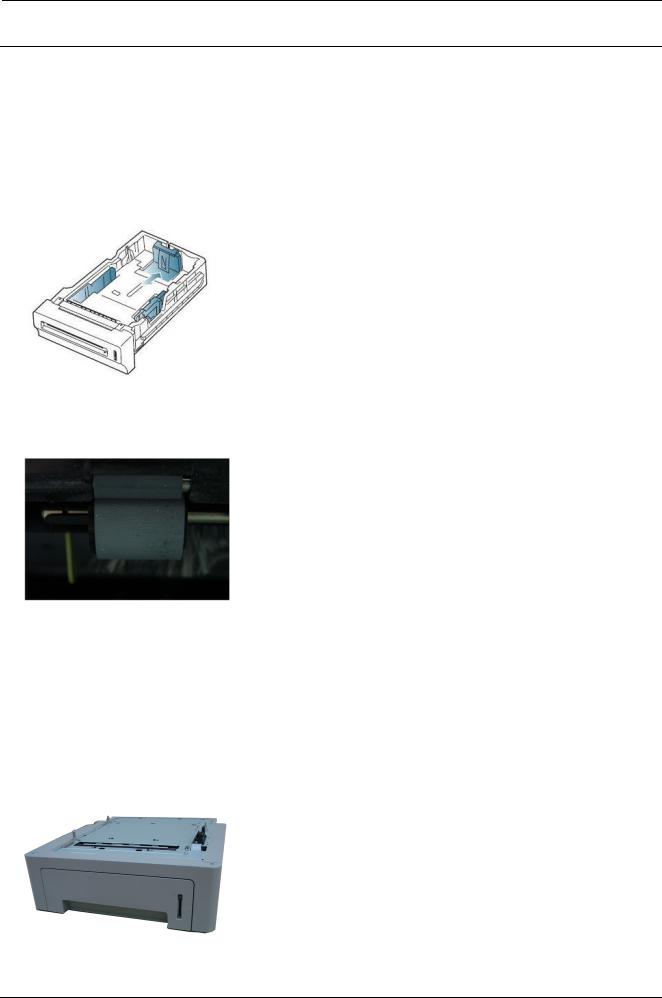
2. Product spec and feature
2.2.4.1. Feeding Section
It is consists of a basic cassette, an MP tray for supplying different types of media (envelope, label, special paper) and parts related to paper transferring.
1)Tray 1 (Basic Tray)
This model has a cassette type tray.
It takes a center loading method and applies ‘semi retard separating method.’ It has a paper existence sensing function, paper arranging function.
In the front side, there is a paper level indicator.
2)Pickup roller
It is to start the initialization of paper feed out of the Cassette Tray, and subsequent transport to the Registration Rollers. The Pick-up roller is driven by a solenoid.
3)Registration Roller
It is used a the primary Registration Roller, which is used to time the paper with the visibly toner image on the Transfer Belt ; it is used as an anti skew device as well.
4)MP Tray
The multi-purpose tray can hold special sizes and types of print material, such as postcards, note cards, and envelopes. It is useful for single page printing on letterhead or colored paper.
5)SCF (Second Cassette Feeder, 2nd / 3rd tray)
SCF is the option unit of CLP-775ND. This additionally stores and automatically feeds printing paper. Its function is the same as the Cassette (1st tray). This SCF can be installed until Max. 2 ea.
Copyright© 1995-2016 SAMSUNG. All rights reserved. |
2-12 |
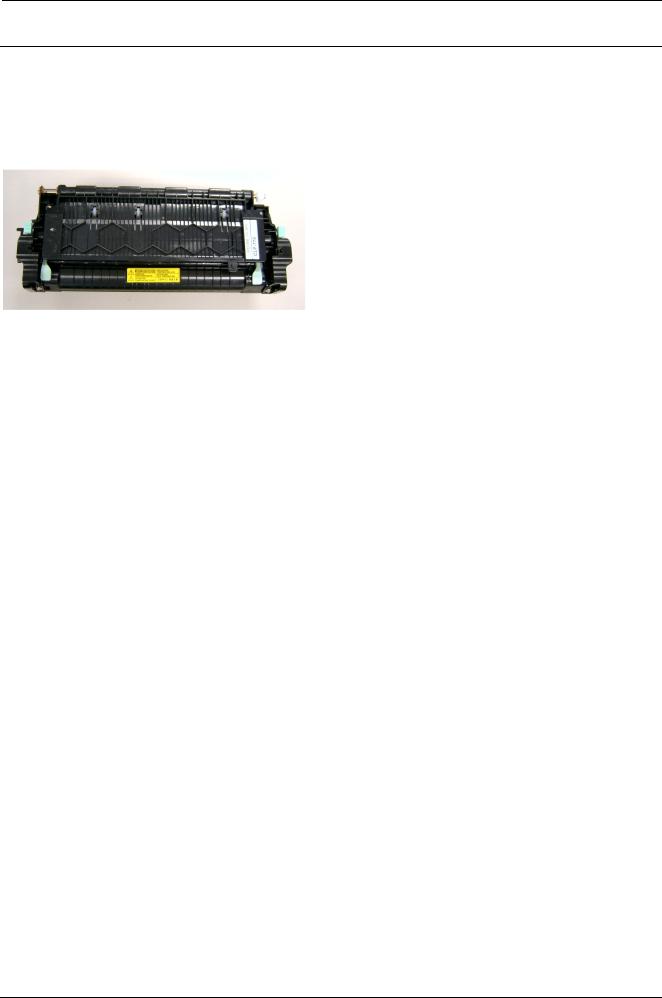
2. Product spec and feature
2.2.4.2. Fuser Unit
This unit consists of Heat Roller, a Thermostat, and Thermistors, etc. It fuses the toner that was transferred by the transfer roller onto the paper, by applying pressure and high temperature to complete fusing process.
•Fusing Type : [Dual Lamp Heating, 800W/500W]
•Heat Roller : Pipe Type (Lamp Inside)
1)Thermostat
When a heat lamp is overheated, a Thermostat cuts off the main power to prevent over-heating.
•Thermostat Type : NonContact type
2)Thermistor
It is a temperature detecting sensor.
3)Fuser Belt
The fuser belt transfers the heat from the lamp to apply a heat on the paper. The surface of the fuser belt is coated with Teflon, so toner does not stick to the surface.
4)Pressure roller
A pressure roller mounted under a heat roller is made of a silicon resin, and the surface also is coated with Teflon. When a paper passes between a heat roller and a pressure roller, toner adheres to the surface of a paper and is permanently fused.
2-13 |
Copyright© 1995-2016 SAMSUNG. All rights reserved. |
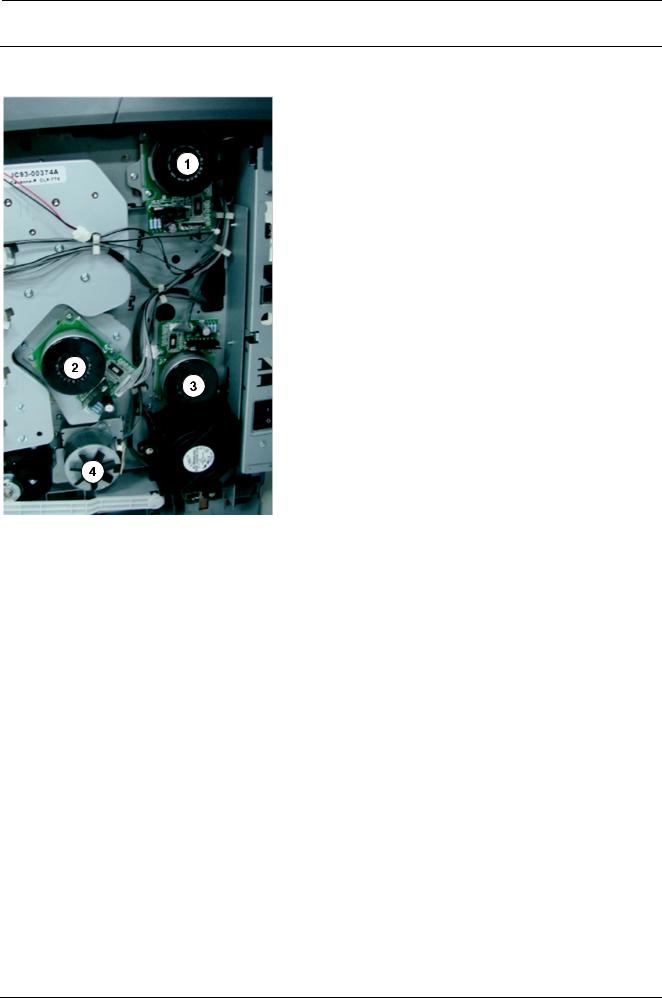
2. Product spec and feature
2.2.4.3. Drive Unit
This product have many motors. These motors drive the PTB unit, fuser unit, feeder unit, exit unit, etc.
No |
Motor |
Function |
1 |
BLDC Motor |
For Fuser Unit |
|
|
|
2 |
BLDC Motor |
For OPC Drive Unit |
|
|
|
3 |
BLDC Motor |
For DEVE Drive Unit |
|
|
|
4 |
Step Motor |
For Feed Drive Unit |
|
|
|
Copyright© 1995-2016 SAMSUNG. All rights reserved. |
2-14 |

2. Product spec and feature
2.2.4.4. LSU (Laser Scanner Unit)
It is the core part of the LBP which switches from the video data received to the controller to the electrostatic latent image on the OPC drum by controlling laser beam, exposing OPC drum, and turning principle of polygon mirror. The OPC drum is turned with the paper feeding speed. The /HSYNC signal is created when the laser beam from LSU reaches the end of the polygon mirror, and the signal is sent to the controller. The controller detects the /HSYNC signal to adjust the vertical line of the image on paper. In other words, after the /HSYNC signal is detected, the image data is sent to the LSU to adjust the left margin on paper. The one side of the polygon mirror is one line for scanning.
Trouble |
Failure Analysis |
Polygon Motor Error |
The Rotation of Polygon Motor can not reach stable. |
|
|
Hsync Error |
Though the rotation of Polygon Motor reach stable, the signal of Hsync is not occurred. |
|
|
2-15 |
Copyright© 1995-2016 SAMSUNG. All rights reserved. |
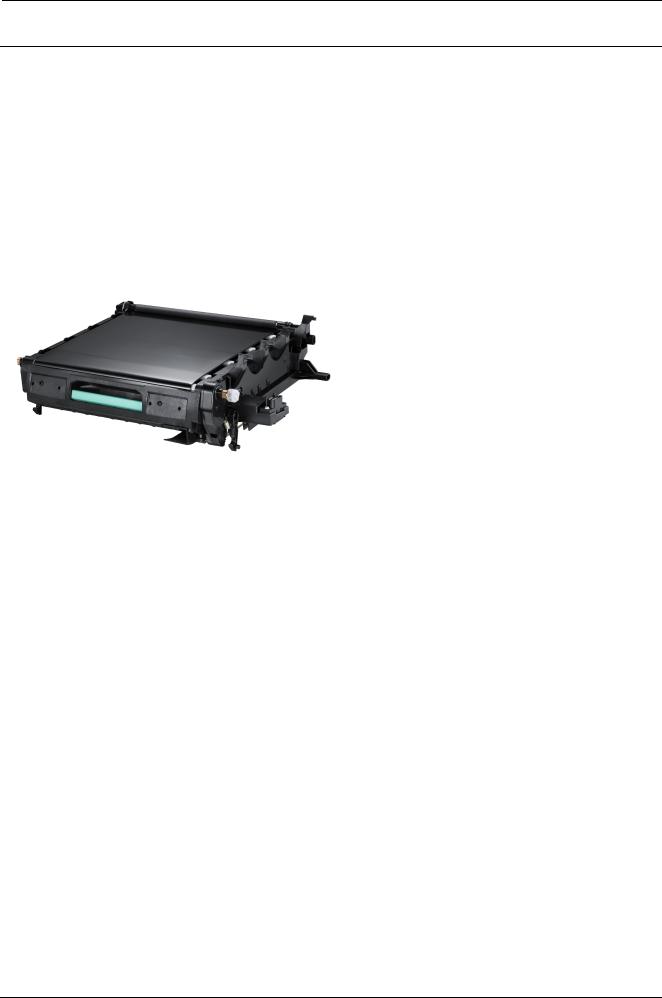
2. Product spec and feature
2.2.4.5. PTB (Paper Transfer Belt) Unit
This unit consists of a transfer belt, transfer roller, duplex unit. waste toner tank, etc. The transfer belt carries the printing paper through OPC drums of each colors. As the paper and transfer belt pass between the transfer roller and the OPC drum, the negatively charged toner images formed on OPC drum are transferred to the printing medium paper by positive bias applied to the transfer roller. The toner images transferred to the paper is melted down and fixed on the paper by the fusing system.
•Belt Cleaning : Collect the toner by using Rubber Blade
•Management of wasted toner : The Waste Toner Tank is equipped.
•Life Span : 50,000 images (Declared yield value in accordance with ISO/IEC 24712)
•Transfer Voltage Control : ADC Control on Conductive Sponge Roller
Copyright© 1995-2016 SAMSUNG. All rights reserved. |
2-16 |
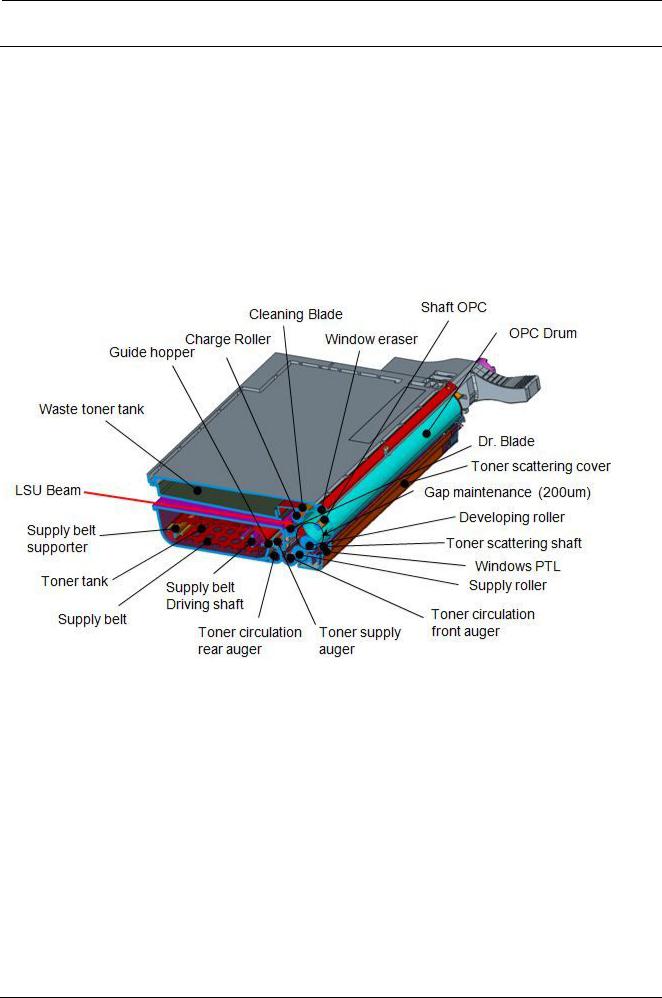
2. Product spec and feature
2.2.4.6. Toner Cartridge
By using the electronic photo process, it creates a visual image. Each toner cartridge consists of the OPC unit and the developing unit. The OPC unit has OPC drum and charging roller, and the toner cartridge unit has toner, supply roller, developing roller, and blade (Doctor blade)
•Developing method: Non-magnetic one-component non-contacting method
•Toner: Non magnetic one-component pulverized toner
•The expected life of toner cartridge : 7,000(YMCK) pages (N/N, Simplex, ISO/IEC 24712 standard pages)
•OPC Cleaning: Collect the toner by using Cleaning Blade
•Method of Toner supply : Toner is carried to the developing roller by supply belt.
2-17 |
Copyright© 1995-2016 SAMSUNG. All rights reserved. |
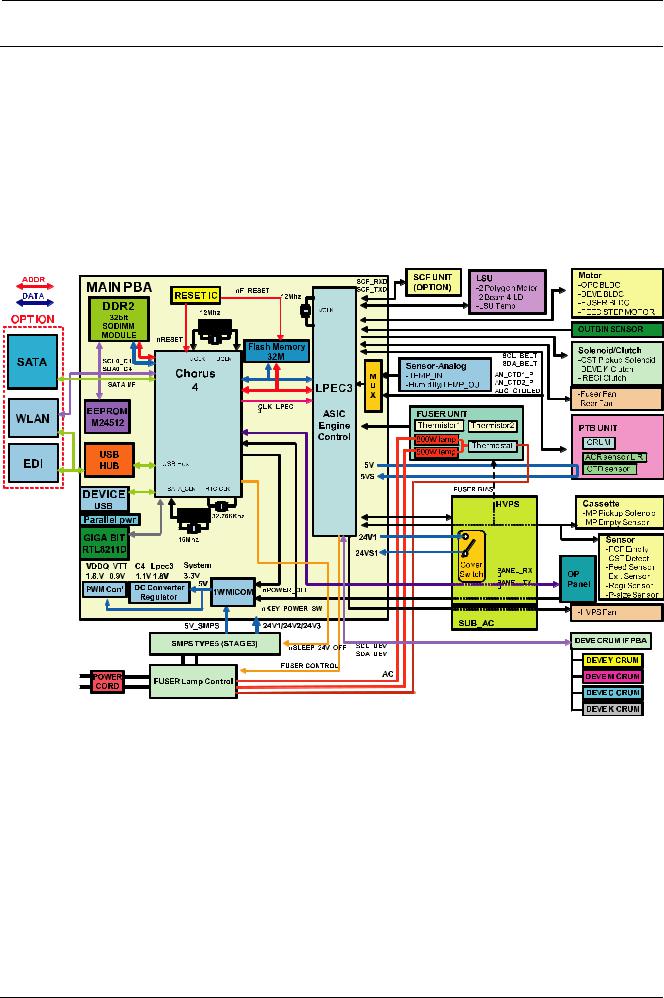
2. Product spec and feature
2.2.5. Hardware Configuration
The CLP-775ND Electrical Circuit System consists of the following:
•Main board
•SMPS board
•HVPS board and HVPS sub board
•Fuser Drive board
•OPE board
CLP-775ND Block Diagram
Copyright© 1995-2016 SAMSUNG. All rights reserved. |
2-18 |

2. Product spec and feature
2.2.5.1. Main PBA
The CLP-775ND system controller consists of a main controller and an engine controller in one-board. The main controller uses a ARMS core chip as main processors, which are dedicated for printing several internal operating blocks through system programs stored in Flash Memory. The engine controller has an engine control SoC, which includes motor drivers, PWM drivers, LSU drivers, sensors, high-voltage drivers, and other driving units for mechanical parts.
NO |
Connector |
NO |
Connector |
NO |
Connector |
1 |
DEVE BLDC 12pin |
12 |
FUSER THERMISTOR 6pin |
23 |
NETWORK JACK |
|
|
|
|
|
|
2 |
OPC BLDC 10pin |
13 |
PTL 8pin |
24 |
DC JACK |
|
|
|
|
|
|
3 |
PTB 14pin |
14 |
FAN Rear 3pin |
25 |
MHV 12pin |
|
|
|
|
|
|
4 |
FEED Motor 6pin |
15 |
BASE DIMM |
26 |
SCF I/F 18pin |
|
|
|
|
|
|
5 |
FUSER BLDC 15pin |
16 |
OPTION DIMM |
27 |
HDD SATA 7pin |
|
|
|
|
|
|
6 |
HUMIDITY sensor 8pin |
17 |
Chorus4 asic |
28 |
FUER HEAT CTL 6pin |
|
|
|
|
|
|
7 |
DEVE CRUM 7pin |
18 |
32MB Flash memory |
29 |
HDD PWR 2pin |
|
|
|
|
|
|
8 |
HVPS Interface 23pin |
19 |
WLAN |
30 |
LSU Temp 2pin |
|
|
|
|
|
|
9 |
HVPS Interface 30pin |
20 |
LPEC3 ASIC |
31 |
LSU 32pin/34pin |
|
|
|
|
|
|
10 |
Cover open 2pin |
21 |
HOST JACK |
32 |
LSU PWR 10pin |
|
|
|
|
|
|
11 |
OUTBIN Sensor 3pin |
22 |
USB JACK |
33 |
SMPS 28pin |
|
|
|
|
|
|
2-19 |
Copyright© 1995-2016 SAMSUNG. All rights reserved. |

2. Product spec and feature
CPU
1) ARM v5TE compliant core 800MHz (I-Cache : 32KB, D-Cache : 32KB)
Memory
1)ROM
•Nor Flash used (32MB)
•Interface With Chorus4 ROM Controller
2)SDRAM
•Size : CLP-775ND(DDR2) : Default 384 MB (Option 512MB)
3)EEPROM
•Size : 512KB
•Interface With SPGPV4 I2C Controller
4)SDRAM
•Size : 256 Byte
I/O Interface
1)USB
•DEVICE : High Speed USB 2.0 (High speed 480Mbps)
•Host : J-SCRIBE Enabler Kit (Full speed 12Mbps)
2)N/W Embedded
•Chorus4 With MII Interface
•Active LED(Yellow) / Link LED(Green)
3)PWM
•High Voltage Control With Duty
•Main Motor Clock
4)I2C Interface
•NVRAM (system information + network information)
•CRUM
Copyright© 1995-2016 SAMSUNG. All rights reserved. |
2-20 |

2. Product spec and feature
2.2.5.2. SMPS board
SMPS( Switching Mode Power Supply ) Board supplies electric power to a Main Board and other boards through a Main Controller by +5V,+24V from 110V/220V power input. It has safety protection modes for over current and load.
•Specification
-AC 110V (90V ~ 135V) / AC 220V (180V ~ 270V)
-Output Power: 192W / Max. 270W
-DC 5V: 24W ~ 30W / DC 24V: 168W ~ 240W
1
2
Varistor
24V Fuse 
5V Fuse
■ Connection
1INPUT_AC (Fuser Drive Board )
2OUTPUT_5V , 24V (Main PBA) INPUT_24V_Control (Main PBA )
2-21 |
Copyright© 1995-2016 SAMSUNG. All rights reserved. |
